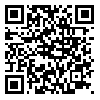دوره 11، شماره 2 - ( 2-1404 )
جلد 11 شماره 2 صفحات 136-125 |
برگشت به فهرست نسخه ها
Download citation:
BibTeX | RIS | EndNote | Medlars | ProCite | Reference Manager | RefWorks
Send citation to:



BibTeX | RIS | EndNote | Medlars | ProCite | Reference Manager | RefWorks
Send citation to:
Mirlohi S, Keyvanloo Shahrestanaki S, Haghani S, Najafi Ghezeljeh T. The Effects of Smartphone-based Learning on the Knowledge, Attitude, and Perception of Disaster Preparedness Among Nurses. JCCNC 2025; 11 (2) :125-136
URL: http://jccnc.iums.ac.ir/article-1-607-fa.html
URL: http://jccnc.iums.ac.ir/article-1-607-fa.html
The Effects of Smartphone-based Learning on the Knowledge, Attitude, and Perception of Disaster Preparedness Among Nurses. نشریه مراقبت پرستاری مددجو محور. 1404; 11 (2) :125-136
چکیده: (1057 مشاهده)
Background: The increasing reliance on technology in various fields has prompted the exploration of smartphone-based learning as a viable educational tool, particularly in the health care sector. Given the significant challenges posed by the COVID-19 pandemic, enhancing nurses’ readiness to respond effectively to disasters and health crises has become more critical. This study aims to evaluate the effects of smartphone-based learning on nurses’ knowledge, attitude, and perception regarding disaster preparedness.
Methods: This quasi-experimental study was conducted in June–September 2020 using a pre-test- post-test control group design in urban hospitals of Falavarjan City-Iran. All 204 eligible nurses in the study settings were recruited and randomly allocated to either a control (n=102) or an intervention (n=102) group. An educational android app was designed and provided to the intervention group for one month. The subjects completed the disaster preparedness evaluation tool (DPET) and the disaster preparedness questionnaire (DPQ) before and one month after the onset of the intervention. The data analysis was conducted using descriptive statistics (absolute and relative frequencies, mean, and standard deviation) and inferential statistics (ANOVA, independent t-test, paired t-test, and chi-square test). The analysis utilized SPSS software, version 22, and a significance level of 0.05 was considered for all statistical tests.
Results: The groups showed no significant differences regarding the pre-test mean scores of disaster preparedness knowledge, attitude, and perception. No significant difference was also seen in the post-test mean score of disaster preparedness knowledge and attitude (P=0.20). However, the post-test mean score of disaster preparedness perception in the intervention group was greater than that in the control group (P<0.001).
Conclusion: Smartphone-based learning can promote nurses’ disaster preparedness perception, particularly during the COVID-19 pandemic.
Methods: This quasi-experimental study was conducted in June–September 2020 using a pre-test- post-test control group design in urban hospitals of Falavarjan City-Iran. All 204 eligible nurses in the study settings were recruited and randomly allocated to either a control (n=102) or an intervention (n=102) group. An educational android app was designed and provided to the intervention group for one month. The subjects completed the disaster preparedness evaluation tool (DPET) and the disaster preparedness questionnaire (DPQ) before and one month after the onset of the intervention. The data analysis was conducted using descriptive statistics (absolute and relative frequencies, mean, and standard deviation) and inferential statistics (ANOVA, independent t-test, paired t-test, and chi-square test). The analysis utilized SPSS software, version 22, and a significance level of 0.05 was considered for all statistical tests.
Results: The groups showed no significant differences regarding the pre-test mean scores of disaster preparedness knowledge, attitude, and perception. No significant difference was also seen in the post-test mean score of disaster preparedness knowledge and attitude (P=0.20). However, the post-test mean score of disaster preparedness perception in the intervention group was greater than that in the control group (P<0.001).
Conclusion: Smartphone-based learning can promote nurses’ disaster preparedness perception, particularly during the COVID-19 pandemic.
| بازنشر اطلاعات | |
 |
این مقاله تحت شرایط Creative Commons Attribution-NonCommercial 4.0 International License قابل بازنشر است. |





